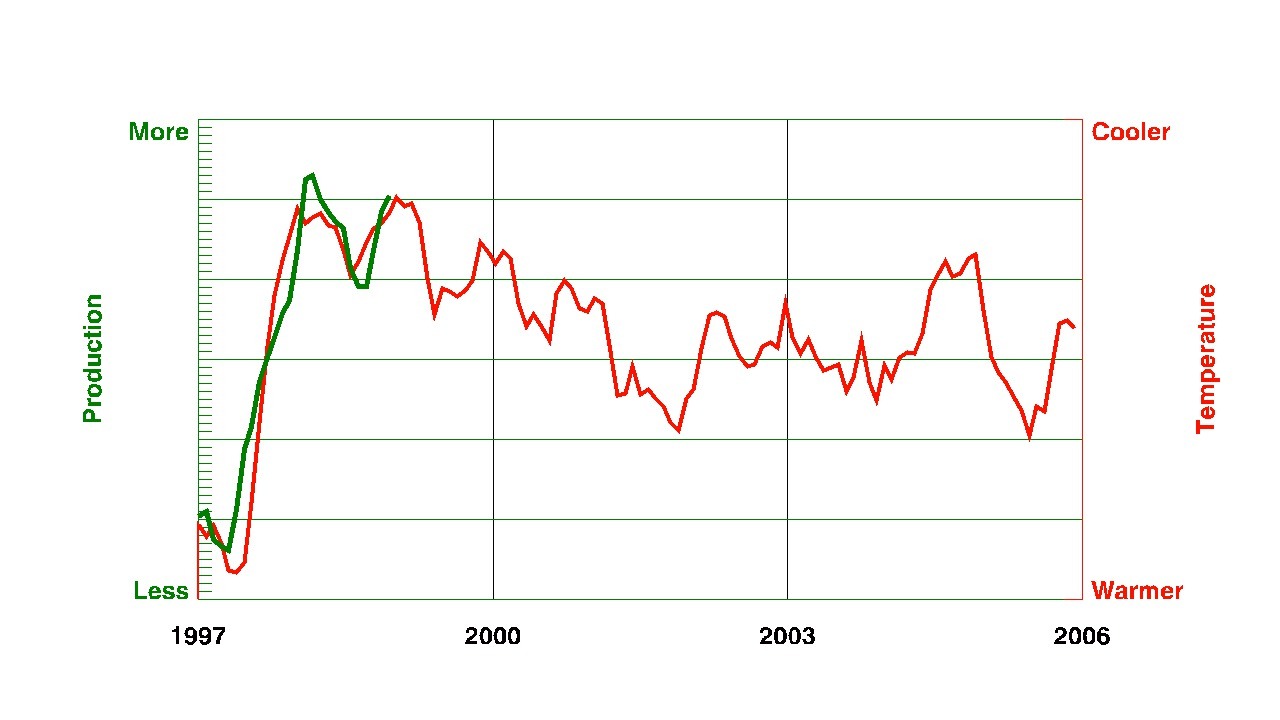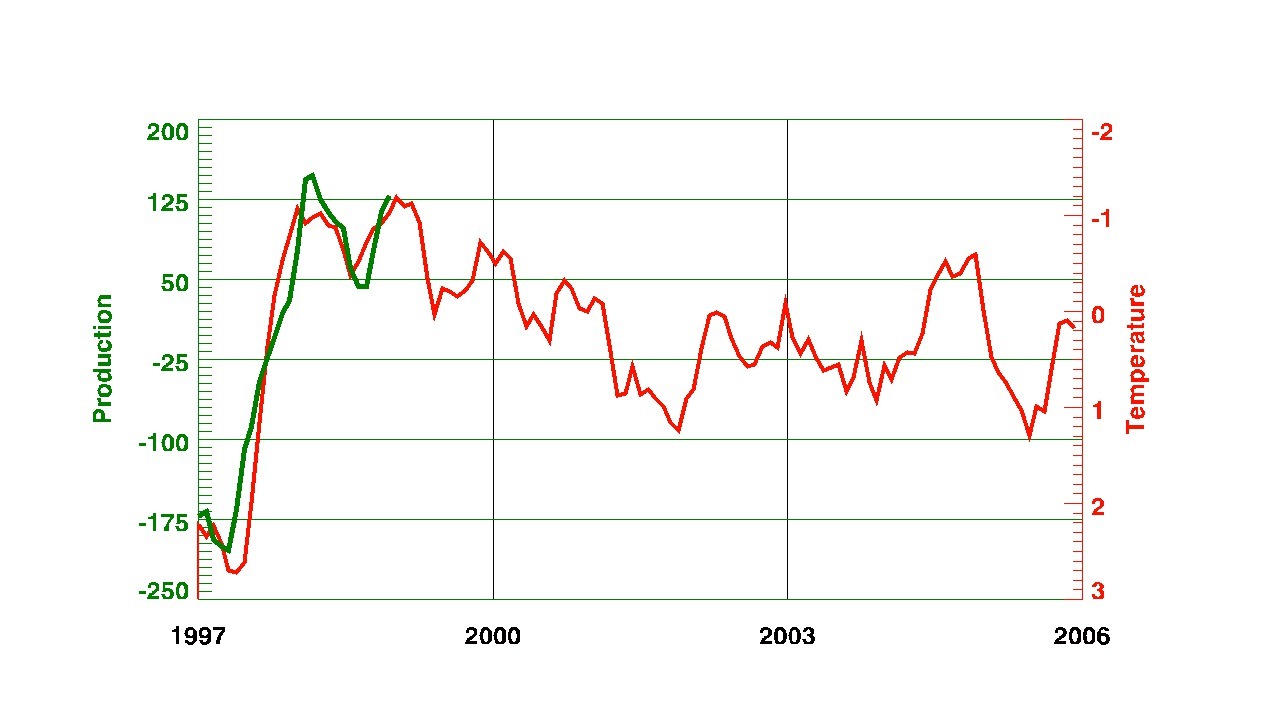Sun
Planets and Moons
ID: 3459
The SeaWiFS instrument aboard the Seastar satellite has been collecting ocean data since 1997. A check up of the Earth's planetary health reveals that the lowest rung in the ocean food chain is shrinking. For the past 20 years (early 1980s to present), phytoplankton concentrations declined as much as 30 percent in northern oceans. Scientists from NASA, the National Oceanic and Atmospheric Administration (NOAA), and Oregon State University say warmer ocean temperatures and low winds may be depriving the tiny ocean plants of necessary nutrients. However, they still do not know if the loss of phytoplankton is a long-term trend or a climate oscillation. Scientists can monitor ocean and planetary health through phytoplankton. Since the whole ocean food chain depends on the health and productivity of phytoplankton, a significant change could indicate a shift in our climate. Phytoplankton consists of many diverse species of microscopic free-floating ocean plants that form the base of the ocean's food chain. These plants thrive on sunlight and nutrients. Limit either one and phytoplankton will not grow. This animation shows the Multivariate ENSO Index (MEI) in red and the net primary production NPP anomaly in units of Tgrams carbon per month in green. The MEI is a multivariate index that incorporates sea level pressure, surface zonal and meridional wind components, sea surface temperature, surface air temperature, and cloudiness (Wolter and Timlin, 1998). The MEI index is calculated for the tropical Pacific (i.e., between 10 degrees North and 10 degrees South, from Asia to the Americas) with units of kg m-3. The Net Primary Production (NPP) data was generated from the Vertically Generalized Production Model (VGPM). The VGPM data set is available at the following URL: http://web.science.oregonstate.eduocean.productivity/ . As the sea surface temperature warms, the production levels decrease.


Multivariate ENSO Index Correlation with Ocean Net Primary Production Data over the North Atlantic


Related Documentation
Visualization Credits
Lori Perkins (NASA/GSFC): Lead Animator
Gene Feldman (NASA/GSFC): Scientist
Michael Behrenfeld (Oregon State University): Scientist
Gene Feldman (NASA/GSFC): Scientist
Michael Behrenfeld (Oregon State University): Scientist
Please give credit for this item to:
NASA/Goddard Space Flight Center, The SeaWiFS Project and GeoEye, Scientific Visualization Studio. NOTE: All SeaWiFS images and data presented on this web site are for research and educational use only. All commercial use of SeaWiFS data must be coordinated with GeoEye (NOTE: In January 2013, DigitalGlobe and GeoEye combined to become one DigitalGlobe.). Data provided by: Mike Behrenfeld (Oregon State University)
NASA/Goddard Space Flight Center, The SeaWiFS Project and GeoEye, Scientific Visualization Studio. NOTE: All SeaWiFS images and data presented on this web site are for research and educational use only. All commercial use of SeaWiFS data must be coordinated with GeoEye (NOTE: In January 2013, DigitalGlobe and GeoEye combined to become one DigitalGlobe.). Data provided by: Mike Behrenfeld (Oregon State University)
Science Paper:
http://www.nature.com/nature/journal/v444/n7120/full/nature05317.html
Short URL to share this page:
https://svs.gsfc.nasa.gov/3459
Data Used:
Note: While we identify the data sets used in these visualizations, we do not store any further details nor the data sets themselves on our site.
This item is part of this series:
Ocean Productivity
Keywords:
DLESE >> Biology
DLESE >> Ecology
SVS >> HDTV
DLESE >> Physical oceanography
GCMD >> Earth Science >> Biosphere
GCMD >> Earth Science >> Climate Indicators
GCMD >> Earth Science >> Biosphere >> Ecological Dynamics >> Food-web Dynamics
NASA Science >> Sun
NASA Science >> Planets and Moons
GCMD keywords can be found on the Internet with the following citation: Olsen, L.M., G. Major, K. Shein, J. Scialdone, S. Ritz, T. Stevens, M. Morahan, A. Aleman, R. Vogel, S. Leicester, H. Weir, M. Meaux, S. Grebas, C.Solomon, M. Holland, T. Northcutt, R. A. Restrepo, R. Bilodeau, 2013. NASA/Global Change Master Directory (GCMD) Earth Science Keywords. Version 8.0.0.0.0
http://www.nature.com/nature/journal/v444/n7120/full/nature05317.html
Short URL to share this page:
https://svs.gsfc.nasa.gov/3459
Data Used:
Multivariate ENSO Index (MEI) also referred to as: MEI
Data Compilation - NOAA - 08/29/1997 - 10/23/2006
The MEI is a multivariate index that incorporates sea level pressure, surface zonal and meridional wind components, sea surface temperature, surface air temperature, and cloudiness (Wolter and Timlin, 1998). The MEI index is calculated for the tropical Pacific (i.e., between 10[degrees]N and 10[degrees]S, from Asia to the Americas).
Vertically Generalized Production Model (VGPM)
Model - Oregon State University - 08/29/1997 - 10/23/2006
The VGPM gives global Net Primary Production (NPP) estimates for the SeaWiFS record that vary strongly with season and range from 3.8 to 4.631015 g of C per month.
NOAA/AVHRR/Sea Surface Temperature
08/29/1997 - 10/23/2006This item is part of this series:
Ocean Productivity
Keywords:
DLESE >> Biology
DLESE >> Ecology
SVS >> HDTV
DLESE >> Physical oceanography
GCMD >> Earth Science >> Biosphere
GCMD >> Earth Science >> Climate Indicators
GCMD >> Earth Science >> Biosphere >> Ecological Dynamics >> Food-web Dynamics
NASA Science >> Sun
NASA Science >> Planets and Moons
GCMD keywords can be found on the Internet with the following citation: Olsen, L.M., G. Major, K. Shein, J. Scialdone, S. Ritz, T. Stevens, M. Morahan, A. Aleman, R. Vogel, S. Leicester, H. Weir, M. Meaux, S. Grebas, C.Solomon, M. Holland, T. Northcutt, R. A. Restrepo, R. Bilodeau, 2013. NASA/Global Change Master Directory (GCMD) Earth Science Keywords. Version 8.0.0.0.0











